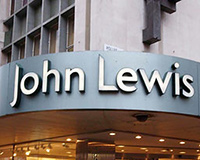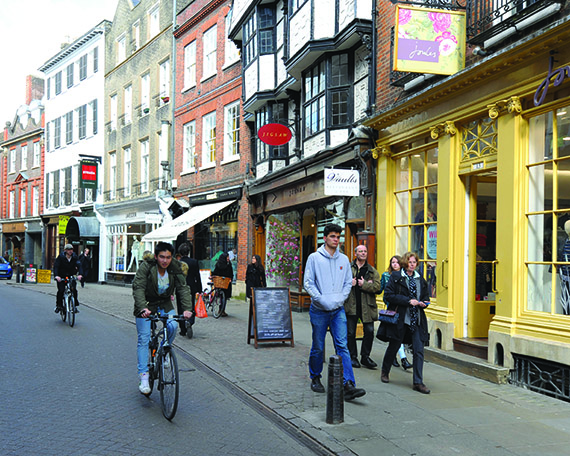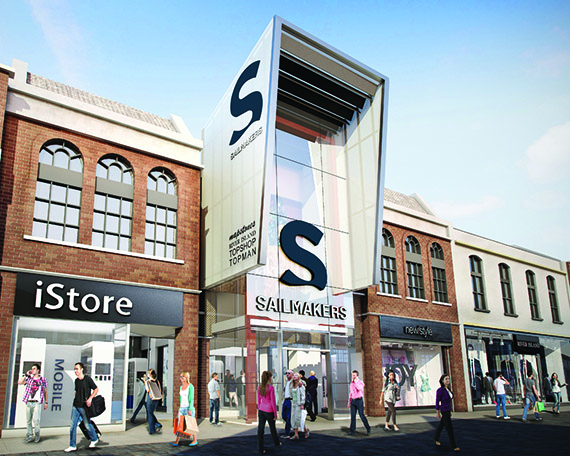While other centres dust themselves down after the recession, Cambridge has emerged almost unscathed. A flight to prime ensured that the historic city’s credentials have continued to attract top-name brands.
As requirements rack up, supply has become ever more constrained. According to agent Bidwells, availability in Cambridge at the end of 2014 fell to 5.1%, with a race for space leading to predictions that zone A retail rents will rise to £250 per sq ft by the end of 2016.
Bidwells’ head of retail and leisure, James Lankfer, says: “Cambridge is pretty much recession-proof. The economy is booming and we benefit from domestic and international tourists, as well as students.”
Since its 2008 opening, the Grand Arcade shopping centre, anchored by John Lewis, has enabled the market to make a step change. Attracting names such as Apple and Hollister, it set the tone for a city where demand consistently outstrips supply.
Recent retail wins include Superdry taking extra space on Petty Cury and the opening of Joules on Sidney Street.
Yet, as elsewhere, some of Cambridge’s most prominent signings have been leisure operators. Almost 40% of the city’s 2014 retail and leisure take-up was by restaurants and cafés, the headline being the opening of Patisserie Valerie in the Grafton Centre.
Meanwhile, Wasabi is fitting out the former Phones 4 U unit on the corner of Petty Cury and Sidney Street and Ed’s Diner has moved into the Grand Arcade. Space is at a premium and Bidwells has a unit adjoining Jamie’s Italian in Wheeler Street under offer to an as-yet unnamed international restaurant brand after receiving a dozen offers.
“Cambridge is almost considered an annex of London and there is always intense interest from leisure operators,” says Fleurets’ Simon Jackaman. “Lack of space is likely to lead to further rental growth.”
 Norwich is also reaping the benefits of a buoyant leisure market. Land Securities’ Riverside Entertainment site, close to the railway station, recently attracted the likes of TGI Friday’s and Coast to Coast, while Bill’s has taken the former Blacks unit at 2-10 Back of the Inns.
Norwich is also reaping the benefits of a buoyant leisure market. Land Securities’ Riverside Entertainment site, close to the railway station, recently attracted the likes of TGI Friday’s and Coast to Coast, while Bill’s has taken the former Blacks unit at 2-10 Back of the Inns.
The city has also exploited an affluent hinterland to maintain a resilient retail market.
When Chapelfield shopping centre opened in 2005, there were fears that the high street would be hit hard, but over time, increased footfall and a new calibre of retail names has benefited Norwich’s wider retail pitch.
The Castle Street and London Street axis has been reinvigorated by lettings to the likes of Joules and Crew Clothing. In 2014, the standout deal was The White Company leasing the former Curry’s unit on Gentleman’s Walk, while Evans Cycles has taken space at Westlegate Tower.
“Norwich is an extremely attractive retail destination, be it broad-brush retail, department stores or independents in Norwich Lanes,” says Adrian Fennell, head of retail and leisure at local agent Roche Chartered Surveyors. “Plans are afoot to move the city even further up the retail rankings.”
Threadneedle’s 2014 purchase of Norwich’s Anglia Square shopping centre could lead to a comprehensive retail-led redevelopment, while the recently completed dualling of the A11 is likely to extend Norwich’s retail catchment further south.
The ability to exploit wealthy outlying areas has been key to the success of both Cambridge and Norwich. Yet, despite its shared status as a county town, Ipswich has struggled to make its mark.
According to Bidwells, availability of retail and leisure space in central Ipswich stands at a hefty 300,000 sq ft and by the end of 2014, availability stood at 21.4%.
 In recent years, Ipswich has failed to attract the type of retailers wooed by its neighbours and, from Habitat in the 1990s to Alders in 2005, has seen a series of department stores shut up shop. When John Lewis opened up in Ipswich in 2012, it did so out of town with a John Lewis at Home store alongside Waitrose at Futura Park.
In recent years, Ipswich has failed to attract the type of retailers wooed by its neighbours and, from Habitat in the 1990s to Alders in 2005, has seen a series of department stores shut up shop. When John Lewis opened up in Ipswich in 2012, it did so out of town with a John Lewis at Home store alongside Waitrose at Futura Park.
Martin Reader from Ipswich agent Reader Commercial says: “The high street looks even worse than it did 12 months ago with the loss of Gap and Clinton Cards.
“Ipswich has never been considered a place to go for a day’s shopping and that really has to be addressed.”
As well as supplying modern, well-configured space to attract retailers, Ipswich also needs to up the ante if it is not to be overlooked by the booming leisure sector.
“For many, the perception is that Ipswich is too far out and lacks significant retailers,” says Fleurets’ Jackaman. “Also, there is no clear prime pitch. I took Strada and Prezzo for a walk around the city and they said they wouldn’t know where to locate.”
He adds: “There are not the offices to generate enough daytime activity on the waterfront, while the city centre lacks the pull of decent retailers, and never the twain shall meet.”
Ipswich council hopes this can be addressed by improving the connectivity of the city centre and waterfront. But the real test will be just how much investment the private sector is willing to make to woo occupiers who have resisted dipping their toes into the market.
Stepping up a gear
As two Ipswich shopping centres are poised for large-scale redevelopment, all eyes are on how successful their owners can be in giving tired space a new lease of life.
When Capital & Regional spent £9.2m to acquire the Buttermarket shopping centre in March, hopes were raised for a change in fortune for Ipswich’s beleaguered retail and leisure markets.
Along with joint-venture development partner Drum Property, Capital & Regional plans to spend a further £26m transforming the 230,000 sq ft centre.
“Ipswich has an undersupply of quality retail and leisure in its central area,” says Capital & Regional director Ken Ford. “Buttermarket is in a dominant location and has substantial vacant space to adapt to create a new retail and leisure hybrid development.”
About 100,000 sq ft of space is still vacant following the 2011 closure of department store TJ Hughes. Ford hopes that space will be occupied by a cinema operator to sit alongside family dining, a gym and mainly ground-floor retail.
Ford would not be drawn on the name of the preferred cinema operator, but says it will be announced when the scheme goes to planning this month.
Operator Vue won planning consent back in 2012 to develop a nine-screen cinema in the centre, but abandoned its plans in February this year. Vue declined to explain its change of heart, but agents hope Buttermarket’s new owner will bring it back to the fold.
Ipswich’s former Odeon site sold at auction last year and is rumoured to have been bought by the owner of Empire Cinema Group, of Leicester Square fame. But the council confirms it has not been in any talks with the new owner and Capital & Regional is moving ahead with plans regardless, aiming to be on site in the summer for a Christmas 2016 completion.
Meanwhile, work is about to start on the £4m refurbishment of another Ipswich shopping centre. The former Tower Ramparts, to be rebranded Sailmakers, was acquired by LaSalle Investment Management in 2011.
LaSalle has committed to a full refurbishment, kickstarted by 2014 lettings to Iceland and Poundland in space vacated by Littlewoods in 2006.
LaSalle’s head of retail, James Boyd-Phillips, says: “The centre clearly needed reinvigorating and some capital committed. It has historically struggled in the face of so much out-of-town retail, but we are investing and progress so far suggests we’ve turned a corner.”
LaSalle has renewed Topshop’s lease and signed Pandora. Since 2011, occupancy has risen from 20% to 85%.
Although Tower Ramparts is likely to focus more at the value end of the market, Boyd-Phillips admits he is courting some of the same retailers as Buttermarket. Healthy competition from investors offering decent retail space may be just what Ipswich needs.
Paul Clement, chief executive of Ipswich Central, the firm responsible for running the town-centre BID, says: “The two investments are a shot in the arm for Ipswich.”













